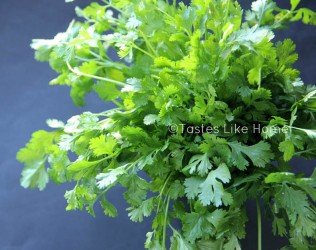Hi Everyone, From the root, to the stems, to the leaves, to the flowers, and seeds, coriander is edible.
Fresh coriander, also known by its Spanish name cilantro, or Chinese parsley, Mexican parsley and dhania is an herb that is widely used in many world cuisines. I think that it is only within the last 10 – 12 years that fresh coriander has made an impact on the herbs plane in many parts of the English-speaking Caribbean. However, Trinidad and Tobago has been using the intensely flavourful culantro/chandon beni in it is cuisine so Trinidadians are very familiar with the flavour notes and profile of the herb. Some even scoff that fresh coriander has nothing on chandon beni. For the rest of us, coriander was always, only, the seeds that are toasted and ground to a powder, either by itself or as part of a spice mix such as garam masala.
 Talking about the names of the herb, it should never be confused with culantro though the spelling and pronunciation is similar. Culantro is also known as saw grass herb due to its long serrated leaves. As I said above, in Trinidad and Tobago, it is the prolifically used and much loved chandon beni. While the flavour profiles are similar, chadon beni is much more intense and profound in flavour. A little goes a long way. If you are ever making a recipe and it calls for fresh cilantro/coriander, do not substitute the exact amount with chadon beni, use only a quarter of the quantity required. On the other hand if the recipe calls for chadon beni and all you have is cilantro/coriander, double the amount of cilantro used. To get the most flavour of fresh coriander, use the roots and stems. Chop finely, puree, pound or grind them up before cooking.
Talking about the names of the herb, it should never be confused with culantro though the spelling and pronunciation is similar. Culantro is also known as saw grass herb due to its long serrated leaves. As I said above, in Trinidad and Tobago, it is the prolifically used and much loved chandon beni. While the flavour profiles are similar, chadon beni is much more intense and profound in flavour. A little goes a long way. If you are ever making a recipe and it calls for fresh cilantro/coriander, do not substitute the exact amount with chadon beni, use only a quarter of the quantity required. On the other hand if the recipe calls for chadon beni and all you have is cilantro/coriander, double the amount of cilantro used. To get the most flavour of fresh coriander, use the roots and stems. Chop finely, puree, pound or grind them up before cooking.

I was introduced to fresh coriander in 2001 while dining at the home of Vietnamese-American friends in the United States. It was one of the most enjoyable, memorable and interactive meals I’ve ever had. The meal consisted of Cá Nướng Trui (Grilled Trout Hand Rolls) and Gỏi Cuốn (fresh spring rolls, summer rolls, salad rolls). The fact that the meal consisted of rolls says that we had to make our own hand and salad rolls. In front of us were large platters of grilled fish and shrimp along with rice noodles, and a myriad of fresh herbs and vegetables along with dipping sauces. Each person had his or her or her own bowl of hot water in which to dip the rice paper wrapper to soften it before laying it out flat, assembling the filling ingredients and wrapping. Among the many herbs was fresh coriander. I immediately fell in love with the flavour and tenderness of the herb with its salad qualities and tones of citrus. After that meal, it seemed like everywhere else I went to eat, fresh coriander was present. Of course that might have something to do with the eateries I frequented – Thai, Chinese, Mexican, cuisines that all use fresh coriander.
When I got back to Barbados I went to several supermarkets in search of cilantro, for that was the name by which I knew the herb. At first I couldn’t find any until I went to the last supermarket on my list, which not only had the cilantro, but luckily, labelled it in such a way that it was easy to identify: coriander/cilantro. I picked up two packets and since then, fresh coriander has become one of my regularly used herbs.
Cilantro/coriander pairs well many other ingredients, such as avocado, mango, pineapple, fish, chicken, lamb, lentils, peas/beans, peppers (hot and sweet), potatoes, rice, tomatoes, vegetables, yogurt, chutneys, salads and salsas. It is an herb that has a natural affinity with citrus, especially limes and lemons. To add it to your food, be sure to use the stems as part of the aromatics you prep to use – onions, garlic etc. Add some of the chopped leaves too but be sure to save most of the fresh leaves to add about 1 minute before the dish is done cooking. Heat diminishes the flavour of the herb (especially the leaves) if it is cooked for too long, that is why it is generally best to add it at the end of cooking. You will find many dishes in which it is added lavishly as a garnish to be mixed into the food before serving and eating. Apart from the flavour and freshness that it brings to everything to which it is added, fresh coriander/cilantro/dhania is rich in Vitamins A, C and K.


The leaves of the herb are very tender and wilt easily. To keep them fresh to last you for a week, cut off some of the excess stem and add the herbs (stem-side down) into a glass with water, cover with thin plastic and refrigerate. Change the water every 2 days. Another way to store them is to rinse and pat them dry, it is important that it is dry; spread them out in an even layer on paper towels, gently roll from one end to the other and add to a zip tight plastic bag and store in the crisper or bin of your refrigerator.
Fresh coriander/cilantro goes from being an herb to a spice when the plant flowers and starts to fruit, bearing seeds that when ripe are yellow-brownish. The seeds are used whole as a pickling spice and also sold ground, in powder form. The seeds are always labelled and sold simply as coriander. Coriander the spice is one of the important spices used in spice blends such as garam masala, harissa, dukkah, and khmeli suneli to name a few. The flavour of the spice is different from that of the fresh coriander leaves; therefore, they should not be used in place of the other.
A final and unrelated note before I go. I hope that you have had those limes preserving in salt as I suggested 3 weeks ago. They are ready for use next Saturday – February 7. See you then!
Cynthia





